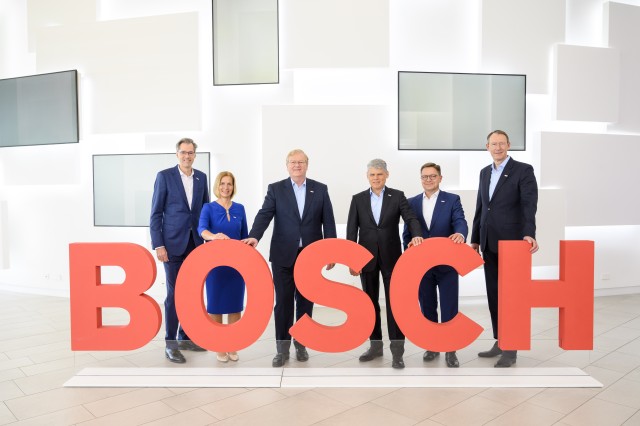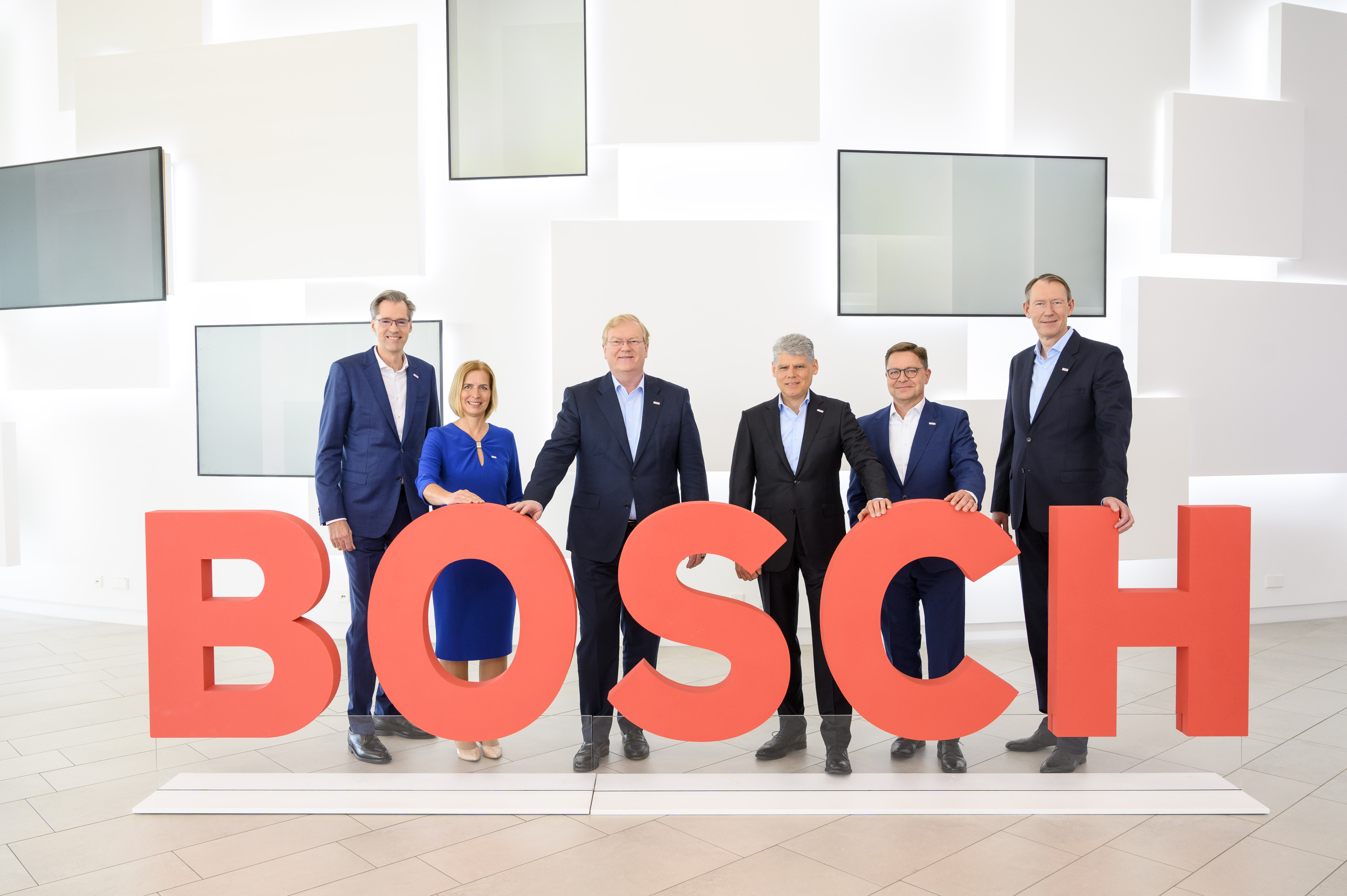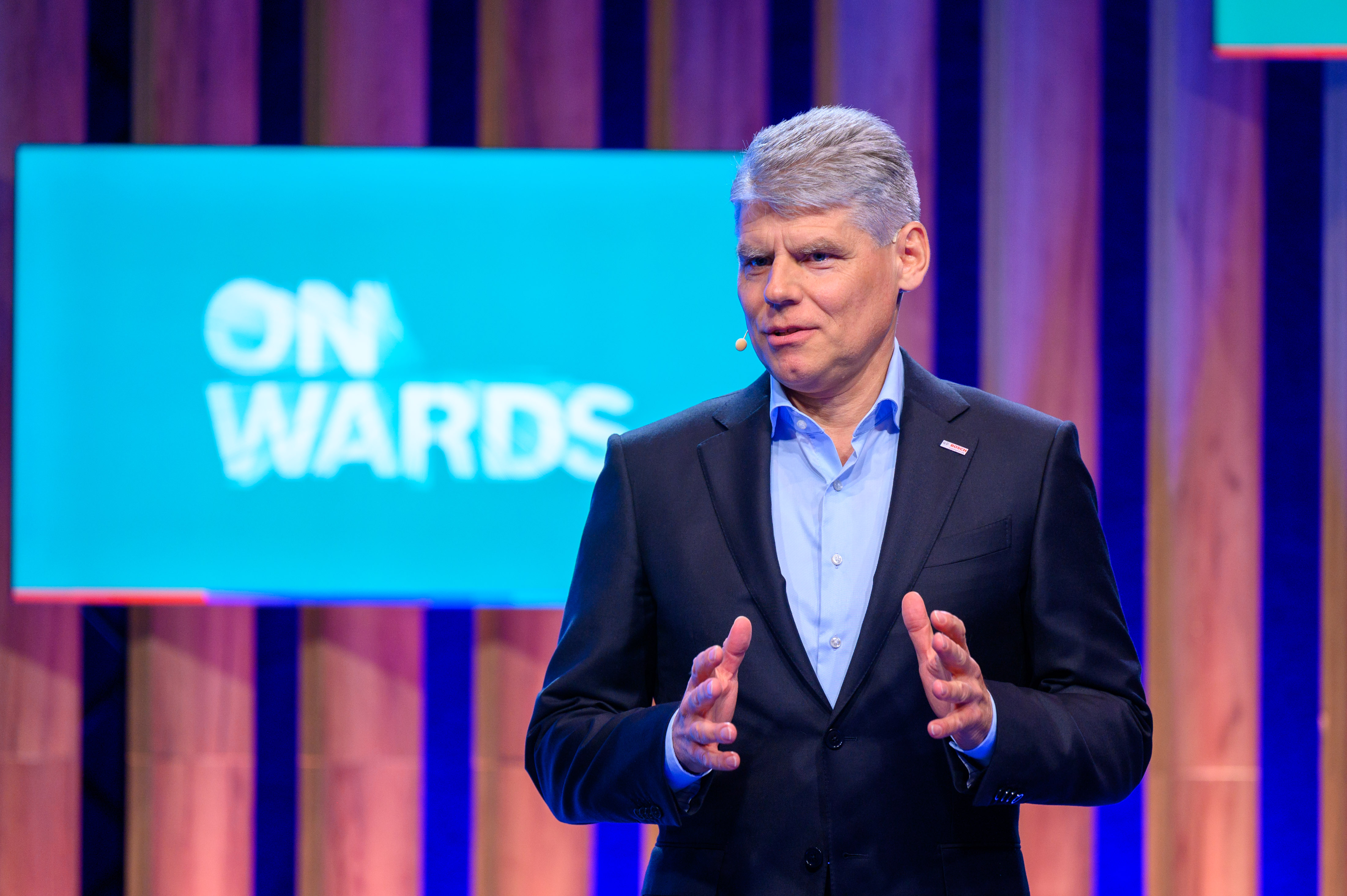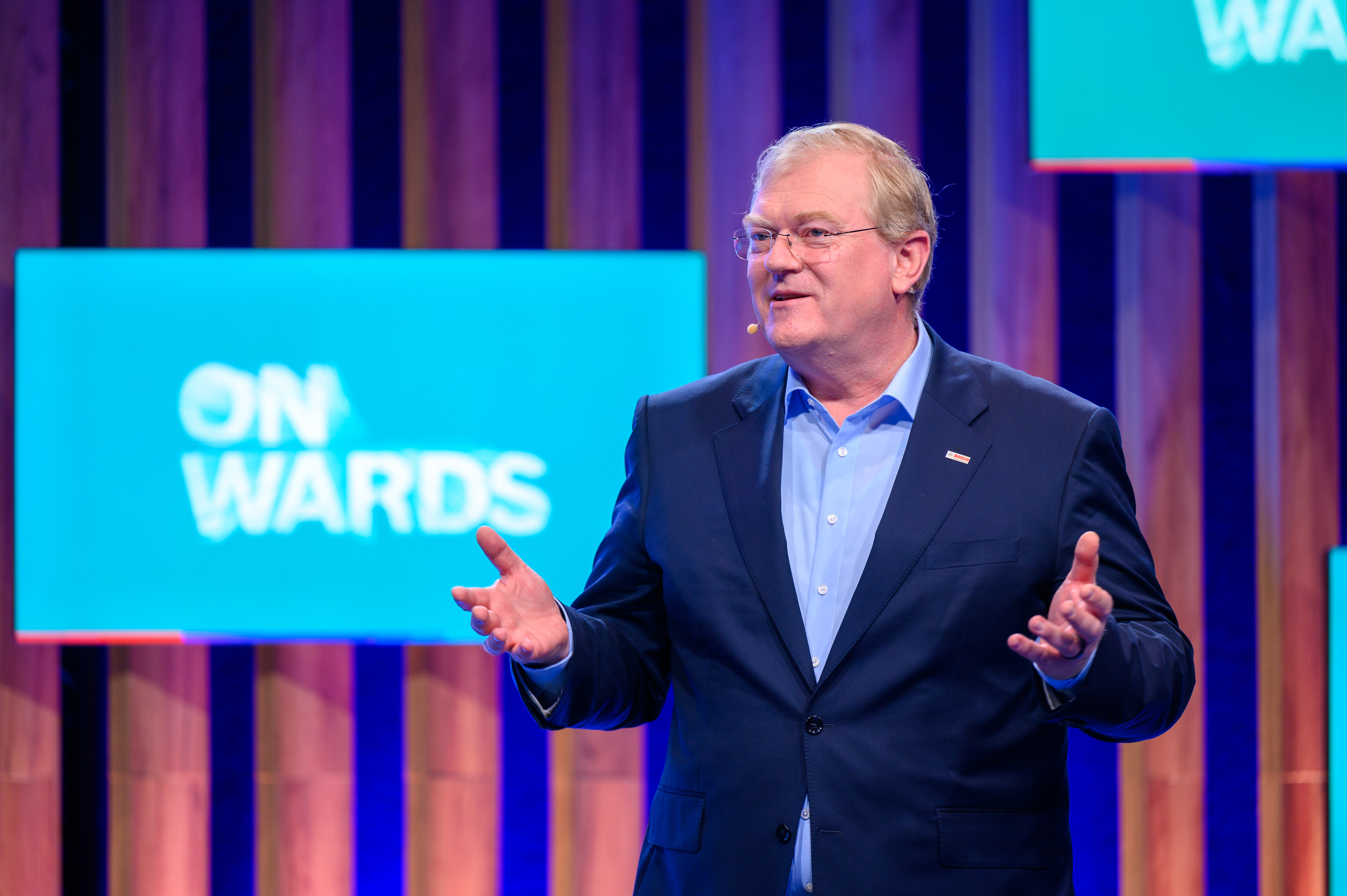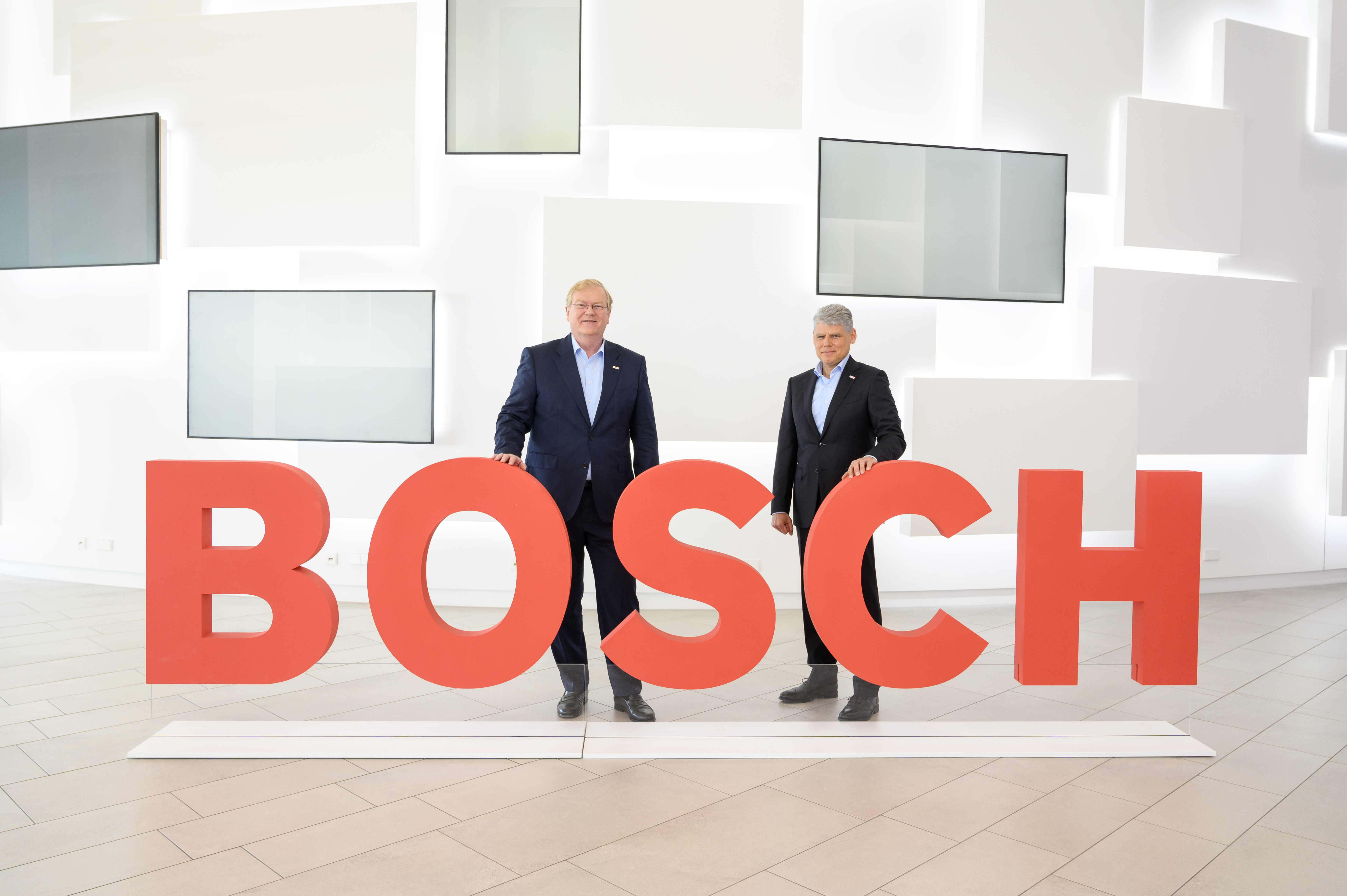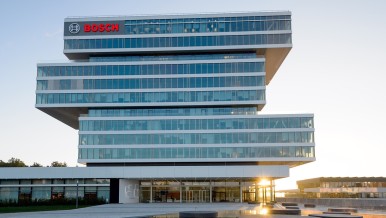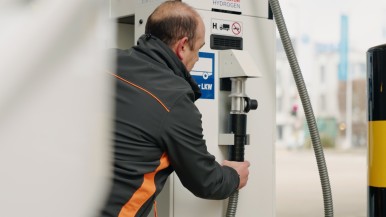Ladies and gentlemen,
Even if the title of our annual report seems to point to better times ahead, “onwards” does not imply that we can simply leave today’s crises behind us. On the contrary: even this annual press conference, to which I offer you a warm welcome, is taking place during a war in Ukraine that shows no sign of ending. Energy scarcity, supply shortages, and inflation also remain unresolved, and mitigating global warming remains a gargantuan task. No doubt about it: we are going through challenging times characterized by overlapping crises. Yet Bosch still managed to navigate its way through 2022 with higher than expected sales growth and a slightly improved margin. Nonetheless, 2023 looks set to be an equally challenging year. So why choose the term “onwards”? Because difficult times do not prevent us from looking to the future. And instead of simply waiting for better times, we are doing everything in our power to bring them about.
So what is it that lifts our gaze beyond the crises that currently confront us? First and foremost, it is our strategic imperative “Invented for life”. It is a fitting ethos for a time in which humanity must rise to the challenge of combating climate change. This is causing considerable economic and social upheaval, and accelerating technological change. Obviously, technology cannot solve all the world’s problems. But it can make a major contribution to climate action, helping to transform our energy systems, our mobility, and, ultimately, our entire living environment. This offers new growth potential for Bosch, but also requires that the company completely reinvent itself.
The opportunities ahead of us are enormous. It comes down to two cru-cial points that we must focus on:
- First, we have to be innovative. That means mobilizing and maintaining the performance and creativity of our associates. It also means building engineering centers, factories, and infrastructure to bring about innovations worldwide.
- At the same time, we have to be profitable. In other words, we need economic clout. Particularly for Bosch, it is crucial to maintain the balance between economic performance and environmental and social aims.
Specifically, we must seize growth opportunities through upfront investments and capital expenditure on the one hand, while maintaining cost discipline and using capital resources highly efficiently on the other. This, too, is essential to our understanding of “onwards” – moving forward with courage and strength, but also with discipline and efficiency.
As we move forward, we are aware that the fight against climate change is causing a profound transformation – a transformation that can be seen from two different perspectives. This fight is a global growth program for new technologies, and we are witnessing a profusion of innovations entering the market, from new semiconductors and sensors to artificial intelligence. But that’s only one side of the story. The other is the displacement of tried and tested technologies. The significant reduction in the use of internal combustion engines in the future will have consequences for Bosch. We have to ready ourselves for the corresponding EU legislation. This is causing anxiety among our associates – we understand that. It’s also one of the reasons why we wish to achieve balanced growth worldwide. One-third of our capital expenditure in 2022 went into Asia Pacific, but we also invested the same amount in Germany. And our decision to expand our business in North America does not mean we have to neglect other parts of the world. We can do more than one thing at the same time – all in all, this will make our regional presence more robust.
Diversification is also the key to our growth strategy for the various business sectors. We still have ample potential to exploit in our existing areas of business, but we can also supplement that with business in adjacent fields and, equally importantly, in new ones. Before I provide some examples to illustrate this point, my colleague Markus Forschner will give you a brief overview of our current business situation ...
Description of the business situation in 2022 and 2023
by Dr. Markus Forschner
Ladies and gentlemen,
Business-wise as well, Bosch faces considerable challenges. These include continuing high prices in the raw material and energy markets, which are helping to push inflation higher, as well as a mediocre economic outlook for the current year. Supply chains also remain impaired, especially in the semiconductor segment. Despite this challenging environment, we have taken crucial steps to prepare the ground and ensure Bosch’s business success, both short- and long-term. We want to be a global technology company that leads the way in multiple sectors, and we want to accelerate our growth. Stefan Hartung will explain this more in a moment. But for me as chief financial officer, this means we have to maintain the delicate balance between capital expenditure and cost discipline.
- We are investing considerable sums in the future and thus also in our current growth, which is being driven by the transformation toward decarbonization and digitalization. So far, this is going well. Ensuring our ability to deliver is crucial to maintaining that.
- To achieve this, however, we also need to be more profitable. We also need to economize as we grow, to reduce inventories, and to ensure that our capital resources are used highly efficiently.
Only then can we maintain our fundamentally conservative financial policy and our sound financial health, which is the basis of our financial independence.
Achieving this balance is no easy task. It asks a great deal of our executives and associates, who are already having to deal with the crises of recent years. Strategic decisions and innovations are required, as well as many task forces, rigorous cost discipline, and the efficient use of capital. What’s more, it is a task that requires us to make constant adjustments, if only because of the significant volatility and pace of market developments.
Our 2022 financial statements once again demonstrated Bosch’s ability to weather difficult times. Nonetheless, last year’s crises also left their mark on our business figures. Since the financial statements do not differ fundamentally from the preliminary figures already published, I only wish to highlight a few points by way of example. The full figures can be found in your press kit and in the annual report.
In 2022, despite the challenging environment, our sales rose by 12 percent to 88.2 billion euros, with volume, exchange-rate, and price effects all contributing to this higher-than-expected figure. Like many others, we were forced to pass on increased costs to our customers in the form of higher prices. This is no easy thing to do, especially in the mobility business. We achieved double-digit growth in all our business sectors, with the exception of Consumer Goods. Mobility Solutions posted strong growth despite ongoing chip shortages and the consequent sluggish increase in automotive production, which rose to 85 million units. Industrial Technology benefited from a relatively stable machinery market, while Energy and Building Technology took advantage of a number of developments, including high demand for climate-friendly heating technology. Consumer Goods saw a considerable fall in market demand following the long and extraordinary boom caused by the coronavirus pandemic, though its sales rose slightly nonetheless.
Despite all the odds, we also raised our EBIT margin from operations to 4.3 percent, compared with 4 percent in the previous year. We did so in spite of increasing our research and development spending by more than we grew our sales – by 1.1 billion euros to 7.2 billion euros, or from 7.8 percent to 8.2 percent of sales. The concerted effort we put into upfront investments is also reflected in the 1-billion-euro increase in capital expenditure to 4.9 billion euros; the capex to sales ratio rose to 5.6 percent, as compared to 5 percent in the previous year.
The highest margins were achieved by Industrial Technology, at 9.8 percent, and Energy and Building Technology, at 6 percent. Mobility Solutions increased its margin from operations to 3.4 percent, which was higher than expected. But this figure was considerably burdened by upfront investments in projects of future importance. Consumer Goods not only felt the effects of consumer reticence, but was also burdened by the almost complete phasing-out of its Russia business. The margin from operations fell to 4.5 percent.
However, maintaining ability to deliver during a period of both great uncertainty and major investments in the company’s future was not without its consequences. We posted a negative free cash flow of 4 billion euros last year. This figure indicates that we did not use cash generated from our business operations to finance growth, but instead relied on our existing financial resources. We have the necessary resources and are in good financial health, with a very respectable equity ratio, which rose to 46.6 percent.
2023 will be another very challenging year. We view the economic climate with a certain degree of skepticism. We expect global economic growth to be just 1.7 percent, which will be a further considerable drop from the previous year’s figure of 2.9 percent. Europe is likely to be hit particularly hard, and may even fall into recession. In North America, we expect the economy to stagnate, though the possibility of a decline in economic output cannot be ruled out. Our forecast for Asia Pacific is for growth of just under 4 percent – attributable to the expected catch-up effects in China following the lifting of restrictions imposed during the coronavirus pandemic.
As before, the reason for these mediocre economic prospects is high prices for energy and raw materials, though we are likely over the peak. Even so, high inflation is expected to remain a challenge not only this year, but also next year. This is forcing central banks to raise interest rates further, with a concomitant dampening effect on the economy. It is likely that these burdens will be intensified by the turbulence in the banking sector. Nonetheless, we believe that the far-reaching and widespread reforms implemented since the financial crisis mean that the financial markets are robust.
The situation is not getting any easier, therefore, even with the expected benefit of catch-up effects in China. For now, however, and particularly during the first two months of 2023, we have continued to feel the economic effects of the restrictions imposed in response to the coronavirus pandemic. Over the first three months of this year, according to comparable internal figures from operations, the global sales of the Bosch Group grew by a modest 3.5 percent quarter on quarter. In Asia Pacific, however, sales declined by 9.3 percent due to the restrictions in China. North America developed particularly favorably, with a double-digit increase of 18 percent. And in Europe, we also achieved reasonably good growth of 7.7 percent.
For the year as a whole, we expect to see sales growth for the Bosch Group in the range of 6 to 9 percent, with the strongest growth in the Mobility Solutions and Energy and Building Technology business sectors. Ignoring any acquisitions, we expect moderate growth in the Industrial Technology business sector. It is likely that the development of sales in Consumer Goods will continue to be relatively subdued, though this is also due to considerable exchange-rate burdens.
We also want to improve our margin from operations in 2023. Our objective is 5 percent – despite continuing pressure on energy, raw materials, and primary products, and even though we will spend at least as much on research and development as in the previous year. The aim is to get yet another step closer to our target margin of at least 7 percent. This will require very hard work on costs in all business sectors, including efficiency gains, especially in the indirect sphere. As in previous years, we will make structural adjustments in various areas. We are also working closely with the employee representatives on this issue. In the long term, we also aim to achieve a better margin on a lasting basis through higher rates of growth in adjacent and new areas of business.
We will also further increase capital expenditure, though we are asking the business sectors to tread cautiously here. Moreover, we will do our best to return inventory levels to normal. What’s more, we will reinforce receivables management and run a critical eye over payment targets on the supplier side. Alongside improving our EBIT margin, therefore, our top priority is to become more efficient in our use of capital resources. Our goal is to achieve a sufficiently positive free cash flow – even if our aim of accelerating growth means we have to make acquisitions to strengthen our position in existing, adjacent, and new areas of business.
So despite all the signs of economic slowdown, we have set ourselves an ambitious roadmap. For 2023, we are determined to achieve good progress in improving profitability and making more efficient use of capital resources, and in this way to create the financial basis for future growth. We all have a lot of work ahead of us at Bosch, but it will be worth all the effort when we consider the major market and growth opportunities ahead. Stefan Hartung is going to tell us about these, so
I’ll hand the floor back to him.
Presentation of long-term growth targets by Dr. Stefan Hartung
Ladies and gentlemen, if we look beyond the current year, I think we can confidently say that we are on exactly the right path with our “Invented for life” strategic imperative. This applies to the major trends of electrification, automation, and digitalization, and more than ever also to the fields of software and artificial intelligence. As the technological transformation continues, it will open up new opportunities for growth that we want to seize. We can accelerate our growth in existing and adjacent areas of business, as well as in new ones. It is essential that these new areas are a good match for us – only then can we apply our strengths of in-depth technological knowledge, experience in the commercialization of innovations, and, last but not least, expertise in volume production. We also continue to add new strengths to this list – for example, the know-how of our software developers. These will soon number 50,000, an unparalleled figure for an enterprise with industrial roots.
Our strategic direction is clear, and I can sum up our objectives in three key points:
- We want to be among the top three providers in the global and regional markets that are relevant to us.
- We want to be firmly and effectively positioned in every region of the world – in the Americas, southeast Asia, and India, as well as in China and Europe.
- Given normal inflation rates, we aim to achieve annual growth of between 6 and 8 percent, with a margin of at least 7 percent and a robust ability to self-finance.
Toward the future of mobility:
we are transforming our core business and achieving success
I can give you examples from across the company of how we are achieving these goals. Let me start with the development of our core Mobility Solutions business – a business that will reach annual sales of 80 billion euros by 2029, but that is already in the throes of a transformation. To illustrate what I mean, let’s take the example of our braking control systems. Even though 2022 was a difficult year, we still saw this part of our business grow by more than 25 percent, which was significantly faster than the market. And ESP 10 will be going into production in the next few weeks. Now you might think that’s simply business as usual, with Bosch gaining market share and then launching a new generation of its electronic guardian angel. But this generation is far more than just an improvement to the hardware. The real innovative leap forward is in the software. Vehicle Dynamics Control 2.0 introduces a new control concept that does an even faster and more accurate job of stabilizing vehicles. It can intervene not only in the braking system, but also in the electrical powertrain and electric steering system. That represents a tangible gain in safety – with considerably less corrective action and shorter braking distances. What’s even more important for the future of our industry is that the new control system does not have to form part of the ESP control unit, but can alternatively be integrated into the central vehicle computer. Indeed, in the future, it will also be available as a standalone software package. It will be part of a vehicle motion management software solution that coordinates every aspect of vehicle motion while taking centralized control of braking, steering, the powertrain, and the chassis.
This example highlights all the key trends that lead to greater safety and efficiency on the road: first, electrification and vehicle automation; second, centralization of the electronics architecture into just a few vehicle computers instead of what can currently be as many as 100 individual control units; and third, the development of the software-defined vehicle, which is fueling the greatest changes of all in our industry’s business. The opportunity to fully experience this development will come with the next vehicle generation, which will be launched in the second half of this decade. We anticipate a threefold increase in software applications and even a tenfold increase in applications that access the cloud. These may include advanced driver assistance functions as well as new charging services. So what are the advantages of this development for automakers and drivers? The software-defined vehicle offers two key benefits.
- First, incorporating new functions into existing systems will in the future be a matter of days instead of years, thanks to the significantly increased speed of development.
- Second, vehicles will continue to be “like new” years after they are delivered to the customer – a “version 2.0,” if you will. The key to this will be the decoupling of software and hardware development. This will make it easier to add new features to motor vehicles – features that arrive in the shape of software updates.
This technological transformation is reflected in economic trends. For example, the overall market for automotive software is expected to be worth 200 billion euros by 2030. Everyone involved in the automotive industry is intensifying their software development activities – manufacturers and suppliers are redoubling their efforts, and tech players, too, are entering the market. Fundamentally, Bosch is well positioned – for example, with basic software that can accommodate chips made by different manufacturers. And while the software component of R&D expenditure in the automotive industry is set to reach 30 percent by 2030, it is already higher than that at Bosch today. More than half the R&D associates in the Bosch Mobility business sector are software developers. Bosch also sees itself as a mobility software company.
That said, this new chapter of automotive engineering is about mastering complexity – the technical complexity of the interaction between the vehicle and cloud and the integration of software from various sources, as well as the challenging organizational and cultural complexity of collaboration between the automotive and IT industries. This requires greater interdisciplinary cooperation, including at Bosch. That’s the fundamental reason behind the reorganization of our mobility sector. Set up to address the changes in market and customer needs, the new-look business sector aims to increase communication and collaboration across former divisional boundaries. This is evident not only in the joint board and in the merger of divisions such as brake and steering systems, but also by the horizontal responsibility that, in the future, will apply to software, vehicle computers, and semiconductors.
We have already taken successful steps toward the future of mobility. Here are some examples from key areas of our business:
- Our electromobility sales will quadruple to reach 6 billion euros by 2026. This year, our sales of electric motors for the automotive powertrain will almost double, just as they did last year.
- We have added 1,500 associates to the ranks of our research and development teams for driver assistance and automated driving. Most of these new associates are software developers, who see Bosch as an attractive employer. We are also on track for growth in this area. For example, our sales of driver assistance systems rose by a solid 20 percent in 2022, which was significantly faster than the market. We are working on the next service levels of these systems in collaboration with partners, such as the VW subsidiary Cariad.
- Last but not least, our innovations for the future of mobility start with the very smallest elements: chips. The market for automotive semiconductors is growing by almost 10 percent annually, and Bosch is growing even faster. Electrification and highly automated driving will mean that chips’ contribution to automotive value creation will more than double. Much of our focus lies on silicon carbide semiconductors, a key technology for electromobility. The market for these semiconductors will grow by an annual 35 percent between now and 2030. Over the course of the decade, we will produce silicon-carbide chips in the United States as well. On this subject, we have just announced an acquisition. We want to take over parts of the American chipmaker TSI Semiconductors, and invest nearly 1.4 billion euros locally over the years ahead.
Each of these points illustrates how Bosch is still capable of leveraging growth potential even in its biggest business sector. Battery-electric mobility is already part of our core business, and other technologies are on the way to achieving that status. At the same time, Bosch is paving the way for hydrogen-based mobility, with the start of production of our fuel-cell powertrain system fast approaching. When it comes to hydrogen, we take the entire value chain into consideration. For example, we are also developing stacks for electrolysis. I’d like to take this opportunity to invite you to our Bosch Tech Day in July, where we’ll be setting out Bosch’s prospects in the future hydrogen economy in more detail.
Growth encompasses more than just vehicles:
seizing opportunities from heat pumps to factory automation
There’s no doubt that the transformation of energy systems is one of Bosch’s biggest growth areas. And we can achieve it not just under the hood, but also in people’s homes. The electrification of heating systems, specifically with heat pumps, is allowing us to achieve the same kind of above-average growth we are seeing with electrical powertrains for cars. We are investing heavily in expanding our capacity in this business area. Since the start of this year, we have also been producing heat pumps at our plant in Eibelshausen, Germany, and we have just announced the construction of a new plant in Poland. To make the modernization of heating systems affordable for homeowners, one of the main things we focus on is hybrid solutions. This might mean combining an existing gas-fired boiler with a heat pump that nonetheless delivers the bulk of the required heat. In most cases, this eliminates the need for costly refurbishment, resulting in modernization costs that can be up to 30 percent lower than a solution solely based on a heat pump. All in all, we expect the European heat pump market to grow by 20 percent in 2023. Our sales are growing over twice as fast – and we will maintain this pace until the middle of this decade.
In all our business sectors, ladies and gentlemen, Bosch is on course for growth. I’d like to offer three more striking examples:
- First, the need for energy and cost efficiency is also driving the technical modernization of commercial buildings, which is helping us expand our building technologies business on both sides of the Atlantic. In the U.S., we are enjoying great success with our subsidiary Climatec, which has doubled its sales and workforce since it was acquired by Bosch in 2015. Regional expansion has played a major role in Climatec’s success. Having branched out from its traditional stronghold in the American West, the company has long since made inroads on the Atlantic coast. These include its role in a flagship project to deliver high-tech building automation for “The Spiral,” a new skyscraper in New York City. Climatec has a good chance of achieving a further doubling of its sales over the next three years. Acquisitions have also given our building-systems business a boost in Europe. The sector is heavily segmented by region on this side of the Atlantic as well. Our acquisition of Protec Fire and Security Group has thus given us a foothold in the British market. In Europe as well, we have expanded our portfolio beyond traditional security technology by moving toward building automation. This is evidenced by two acquisitions: GFR and Hörburger. These have turned out to be a useful addition to our business. Over the past two years, our order intake for building automation in Europe has risen by 50 percent.
- Second, we have set ambitious growth targets for our consumer goods business. For example, we want to more than double our sales of power tools by 2030 to surpass the 10-billion-euro mark. To achieve this, we invested a good 300 million euros last year alone – for example, in efforts to expand our lucrative accessories business. This year, we plan to invest a further nine-figure sum in this area. Much of our focus here lies on North America – a region that accounts for over 40 percent of the global power tool market. BSH Hausgeräte is also further strengthening its international presence. From 2024 onward, for example, it will be manufacturing cooling appliances for the North American market in a new factory in Mexico.
- Third, we are also on course to grow our business in industrial technology. In this area, we want to grow our sales from their current level of 7 billion euros to 10 billion euros by 2028. This is important in order to be among the frontrunners in this industry. Acquisitions will always play an important strategic role in reaching this goal, as illustrated by the example of HydraForce in North America. This acquisition not only tripled our sales of compact hydraulics; HydraForce’s dealer network also gave us better access to the U.S. market. At the same time, acquisitions are helping us make headway in factory automation. This is a business area in which we aim to achieve double-digit growth every year. We have succeeded in setting an industry standard in the form of ctrlX Automation, an open control platform that already has 80 partner applications in its app store. Finally, we are entering a new field of business with the electrification of mobile machinery. To this end, it has now launched its comprehensive eLion range of products – and has also gained a large number of orders from manufacturers of off-highway vehicles. Emissions and noise regulations are becoming stricter in off-road applications, too – for example, in ports, mining, construction sites, and agriculture. The electrification of tractors, concrete mixers, and excavators has proved to be just what the industry has been waiting for. With Bosch Rexroth, we are the number one partner globally for mobile hydraulics – and we have the same goal when it comes to electrical powertrains for mobile machinery.
- Finally, we are entering a new field of business with the electrification of mobile machinery. To this end, it has now launched its comprehensive eLion range of products – and has also gained a large number of orders from manufacturers of off-highway vehicles. Emissions and noise regulations are becoming stricter in off-road applications, too – for example, in ports, mining, construction sites, and agriculture. The electrification of tractors, concrete mixers, and excavators has proved to be just what the industry has been waiting for. With Bosch Rexroth, we are the number one partner globally for mobile hydraulics – and we have the same goal when it comes to electrical powertrains for mobile machinery.
Ladies and gentlemen, this example brings me to the end of my talk. Overall, it is clear that Bosch and its “Invented for life” ethos are currently situated at the center of several important trends. Stopping climate change requires electrification, which we currently offer in all our business sectors. Yet climate action also calls for the kinds of efficient solutions fostered by automation and digitalization. Understood correctly, climate action can trigger a wave of innovation in business and society. We can let the wave carry us, but we can also harness and strengthen it through our research and development activities. By the end of this year, to give another example, all our products will have been equipped, developed, or manufactured with artificial intelligence. We originally expected to achieve this target in 2025, but we are now on track to achieve it sooner. We still have plenty of innovative strength, and that enables us to do two things at the same time: first, to make our contribution to tackling the ecological challenges of our age and, second, to foster our own growth. The progress we’re achieving with our technology “Invented for life” is leading Bosch “onwards.”

